Factors Influencing the Price of Housing Sector in UK
VerifiedAdded on 2023/01/11
|13
|3143
|70
AI Summary
This report discusses the factors that influence the price of the housing sector in the UK, focusing on demand and supply analysis. It explores the impact of interest rates, stamp duty, population, and other factors on the housing market. Additionally, it evaluates government policies that affect the demand for private renting houses in the UK.
Contribute Materials
Your contribution can guide someone’s learning journey. Share your
documents today.
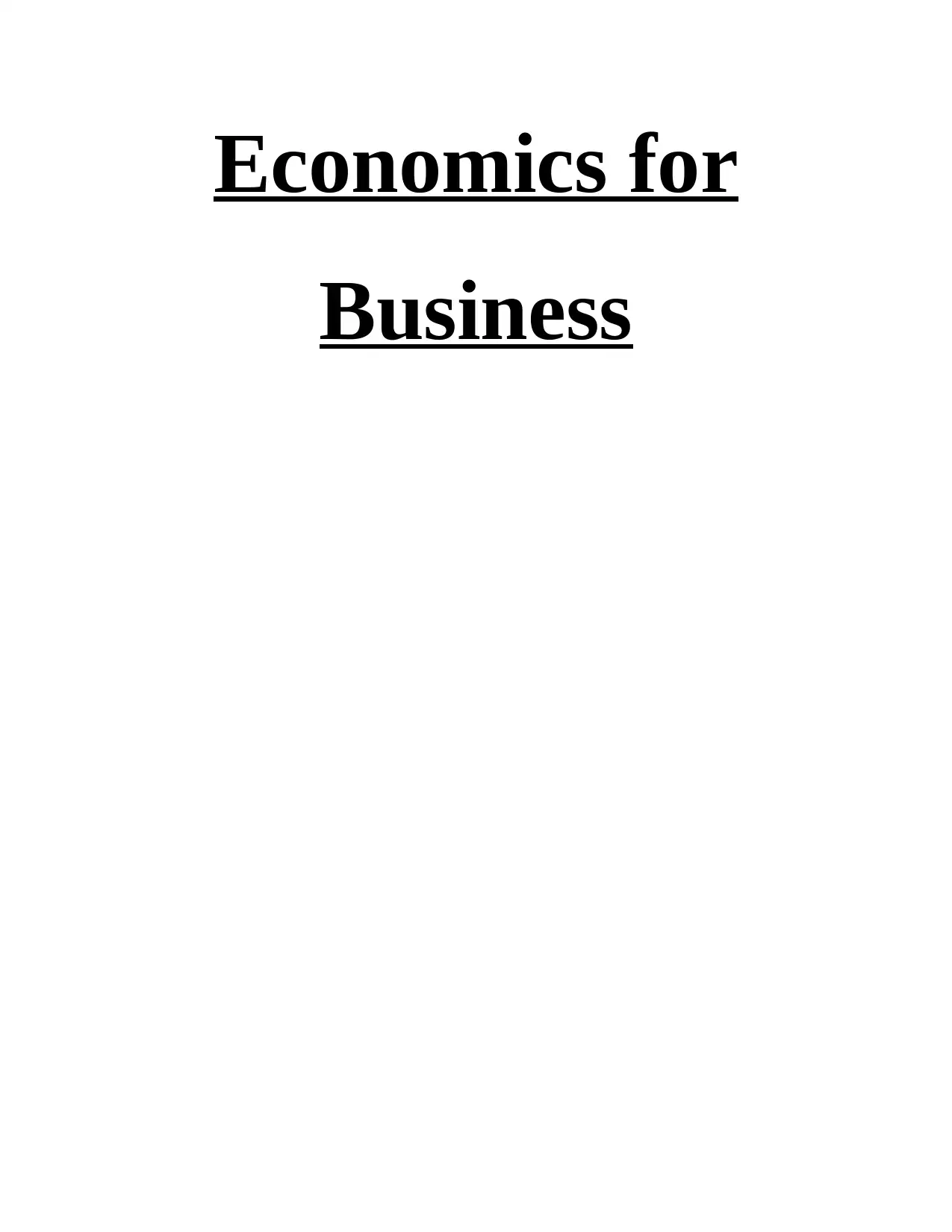
Economics for
Business
Business
Secure Best Marks with AI Grader
Need help grading? Try our AI Grader for instant feedback on your assignments.
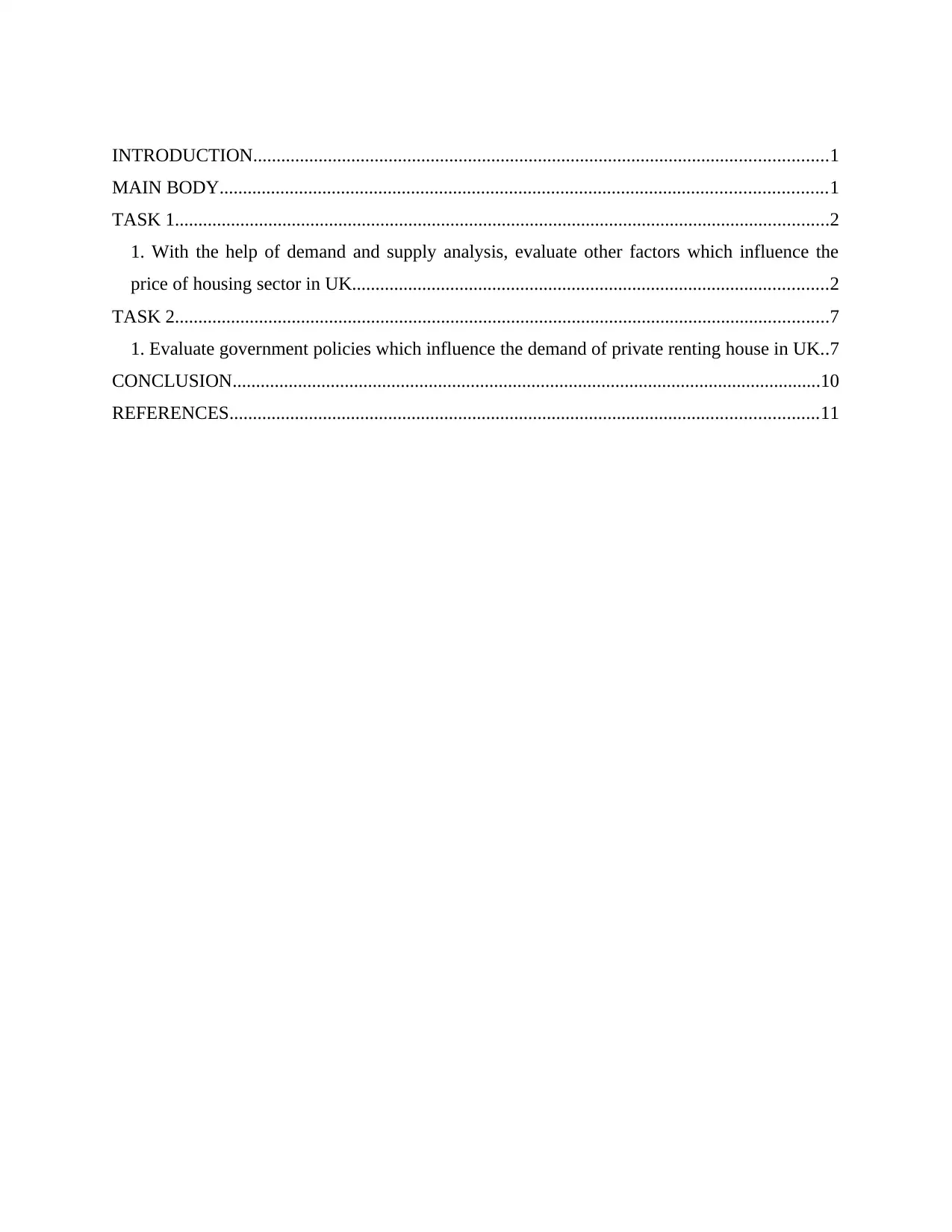
INTRODUCTION...........................................................................................................................1
MAIN BODY..................................................................................................................................1
TASK 1............................................................................................................................................2
1. With the help of demand and supply analysis, evaluate other factors which influence the
price of housing sector in UK......................................................................................................2
TASK 2............................................................................................................................................7
1. Evaluate government policies which influence the demand of private renting house in UK..7
CONCLUSION..............................................................................................................................10
REFERENCES..............................................................................................................................11
MAIN BODY..................................................................................................................................1
TASK 1............................................................................................................................................2
1. With the help of demand and supply analysis, evaluate other factors which influence the
price of housing sector in UK......................................................................................................2
TASK 2............................................................................................................................................7
1. Evaluate government policies which influence the demand of private renting house in UK..7
CONCLUSION..............................................................................................................................10
REFERENCES..............................................................................................................................11
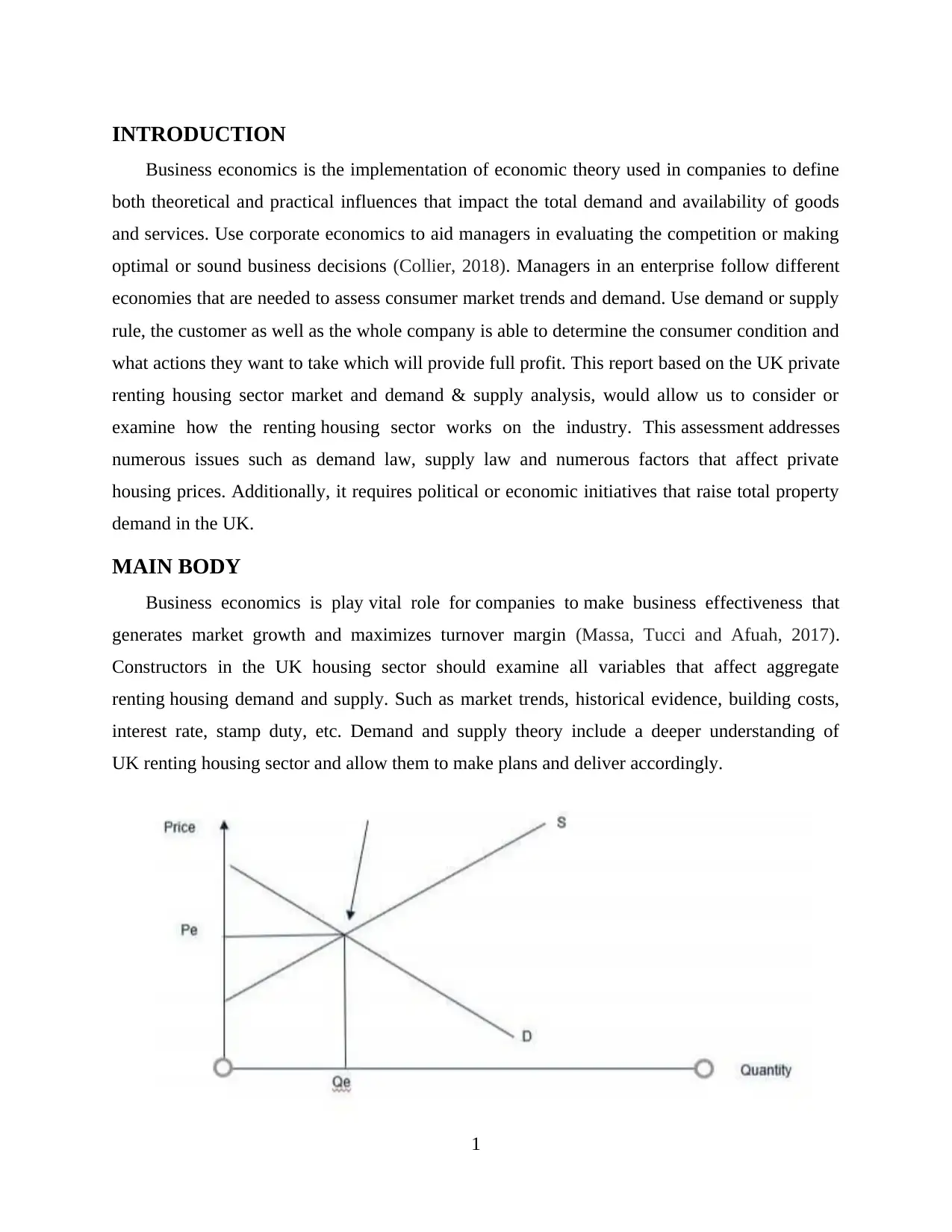
INTRODUCTION
Business economics is the implementation of economic theory used in companies to define
both theoretical and practical influences that impact the total demand and availability of goods
and services. Use corporate economics to aid managers in evaluating the competition or making
optimal or sound business decisions (Collier, 2018). Managers in an enterprise follow different
economies that are needed to assess consumer market trends and demand. Use demand or supply
rule, the customer as well as the whole company is able to determine the consumer condition and
what actions they want to take which will provide full profit. This report based on the UK private
renting housing sector market and demand & supply analysis, would allow us to consider or
examine how the renting housing sector works on the industry. This assessment addresses
numerous issues such as demand law, supply law and numerous factors that affect private
housing prices. Additionally, it requires political or economic initiatives that raise total property
demand in the UK.
MAIN BODY
Business economics is play vital role for companies to make business effectiveness that
generates market growth and maximizes turnover margin (Massa, Tucci and Afuah, 2017).
Constructors in the UK housing sector should examine all variables that affect aggregate
renting housing demand and supply. Such as market trends, historical evidence, building costs,
interest rate, stamp duty, etc. Demand and supply theory include a deeper understanding of
UK renting housing sector and allow them to make plans and deliver accordingly.
1
Business economics is the implementation of economic theory used in companies to define
both theoretical and practical influences that impact the total demand and availability of goods
and services. Use corporate economics to aid managers in evaluating the competition or making
optimal or sound business decisions (Collier, 2018). Managers in an enterprise follow different
economies that are needed to assess consumer market trends and demand. Use demand or supply
rule, the customer as well as the whole company is able to determine the consumer condition and
what actions they want to take which will provide full profit. This report based on the UK private
renting housing sector market and demand & supply analysis, would allow us to consider or
examine how the renting housing sector works on the industry. This assessment addresses
numerous issues such as demand law, supply law and numerous factors that affect private
housing prices. Additionally, it requires political or economic initiatives that raise total property
demand in the UK.
MAIN BODY
Business economics is play vital role for companies to make business effectiveness that
generates market growth and maximizes turnover margin (Massa, Tucci and Afuah, 2017).
Constructors in the UK housing sector should examine all variables that affect aggregate
renting housing demand and supply. Such as market trends, historical evidence, building costs,
interest rate, stamp duty, etc. Demand and supply theory include a deeper understanding of
UK renting housing sector and allow them to make plans and deliver accordingly.
1
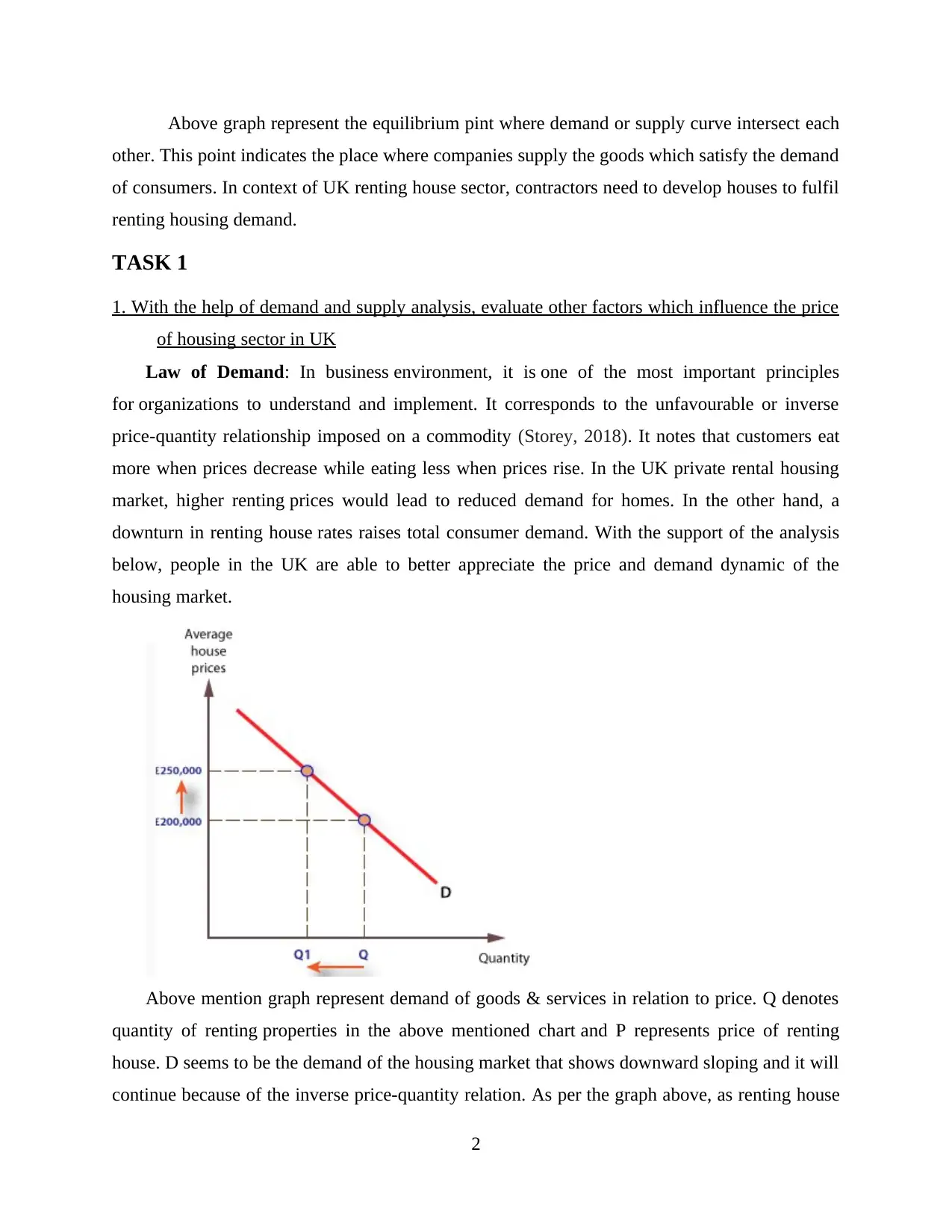
Above graph represent the equilibrium pint where demand or supply curve intersect each
other. This point indicates the place where companies supply the goods which satisfy the demand
of consumers. In context of UK renting house sector, contractors need to develop houses to fulfil
renting housing demand.
TASK 1
1. With the help of demand and supply analysis, evaluate other factors which influence the price
of housing sector in UK
Law of Demand: In business environment, it is one of the most important principles
for organizations to understand and implement. It corresponds to the unfavourable or inverse
price-quantity relationship imposed on a commodity (Storey, 2018). It notes that customers eat
more when prices decrease while eating less when prices rise. In the UK private rental housing
market, higher renting prices would lead to reduced demand for homes. In the other hand, a
downturn in renting house rates raises total consumer demand. With the support of the analysis
below, people in the UK are able to better appreciate the price and demand dynamic of the
housing market.
Above mention graph represent demand of goods & services in relation to price. Q denotes
quantity of renting properties in the above mentioned chart and P represents price of renting
house. D seems to be the demand of the housing market that shows downward sloping and it will
continue because of the inverse price-quantity relation. As per the graph above, as renting house
2
other. This point indicates the place where companies supply the goods which satisfy the demand
of consumers. In context of UK renting house sector, contractors need to develop houses to fulfil
renting housing demand.
TASK 1
1. With the help of demand and supply analysis, evaluate other factors which influence the price
of housing sector in UK
Law of Demand: In business environment, it is one of the most important principles
for organizations to understand and implement. It corresponds to the unfavourable or inverse
price-quantity relationship imposed on a commodity (Storey, 2018). It notes that customers eat
more when prices decrease while eating less when prices rise. In the UK private rental housing
market, higher renting prices would lead to reduced demand for homes. In the other hand, a
downturn in renting house rates raises total consumer demand. With the support of the analysis
below, people in the UK are able to better appreciate the price and demand dynamic of the
housing market.
Above mention graph represent demand of goods & services in relation to price. Q denotes
quantity of renting properties in the above mentioned chart and P represents price of renting
house. D seems to be the demand of the housing market that shows downward sloping and it will
continue because of the inverse price-quantity relation. As per the graph above, as renting house
2
Secure Best Marks with AI Grader
Need help grading? Try our AI Grader for instant feedback on your assignments.
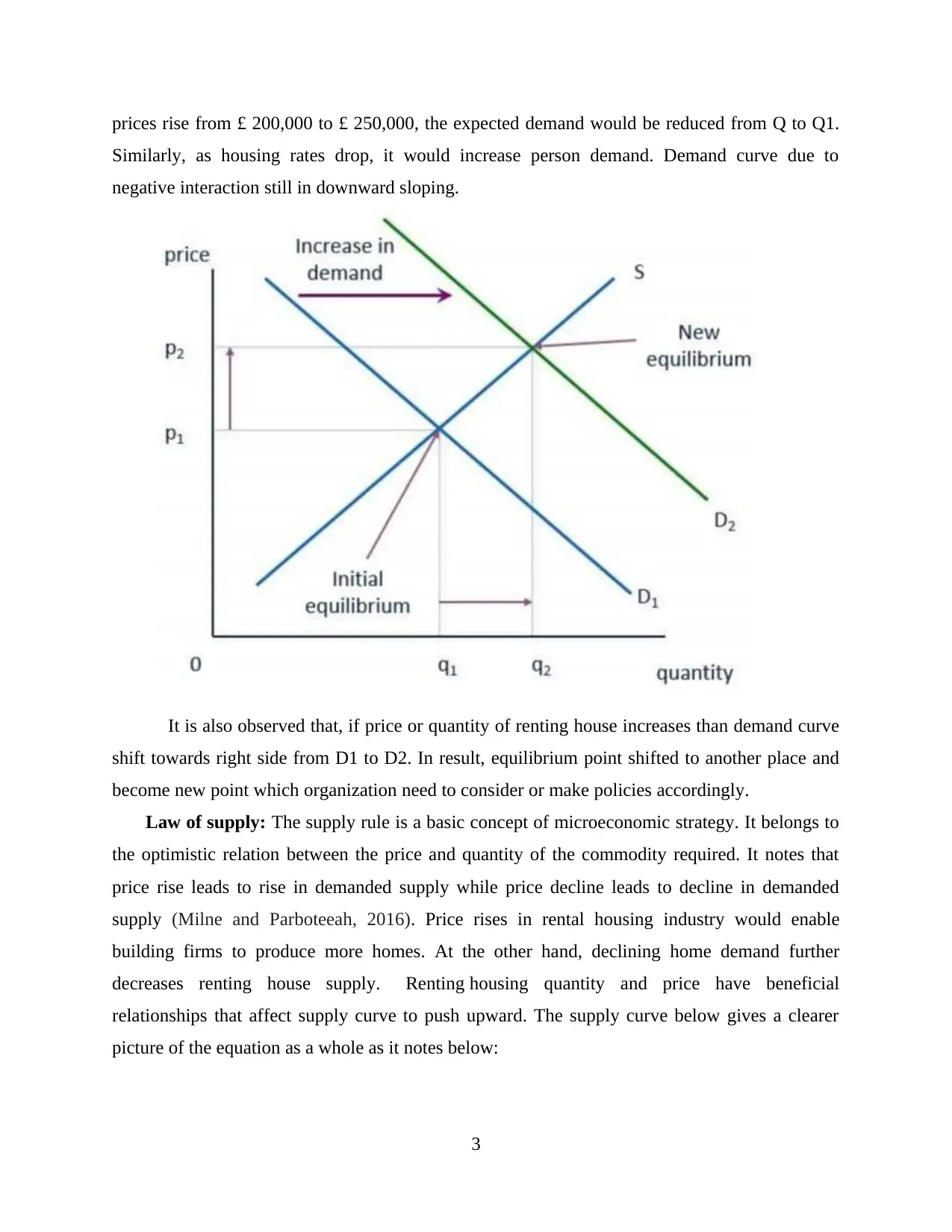
prices rise from £ 200,000 to £ 250,000, the expected demand would be reduced from Q to Q1.
Similarly, as housing rates drop, it would increase person demand. Demand curve due to
negative interaction still in downward sloping.
It is also observed that, if price or quantity of renting house increases than demand curve
shift towards right side from D1 to D2. In result, equilibrium point shifted to another place and
become new point which organization need to consider or make policies accordingly.
Law of supply: The supply rule is a basic concept of microeconomic strategy. It belongs to
the optimistic relation between the price and quantity of the commodity required. It notes that
price rise leads to rise in demanded supply while price decline leads to decline in demanded
supply (Milne and Parboteeah, 2016). Price rises in rental housing industry would enable
building firms to produce more homes. At the other hand, declining home demand further
decreases renting house supply. Renting housing quantity and price have beneficial
relationships that affect supply curve to push upward. The supply curve below gives a clearer
picture of the equation as a whole as it notes below:
3
Similarly, as housing rates drop, it would increase person demand. Demand curve due to
negative interaction still in downward sloping.
It is also observed that, if price or quantity of renting house increases than demand curve
shift towards right side from D1 to D2. In result, equilibrium point shifted to another place and
become new point which organization need to consider or make policies accordingly.
Law of supply: The supply rule is a basic concept of microeconomic strategy. It belongs to
the optimistic relation between the price and quantity of the commodity required. It notes that
price rise leads to rise in demanded supply while price decline leads to decline in demanded
supply (Milne and Parboteeah, 2016). Price rises in rental housing industry would enable
building firms to produce more homes. At the other hand, declining home demand further
decreases renting house supply. Renting housing quantity and price have beneficial
relationships that affect supply curve to push upward. The supply curve below gives a clearer
picture of the equation as a whole as it notes below:
3
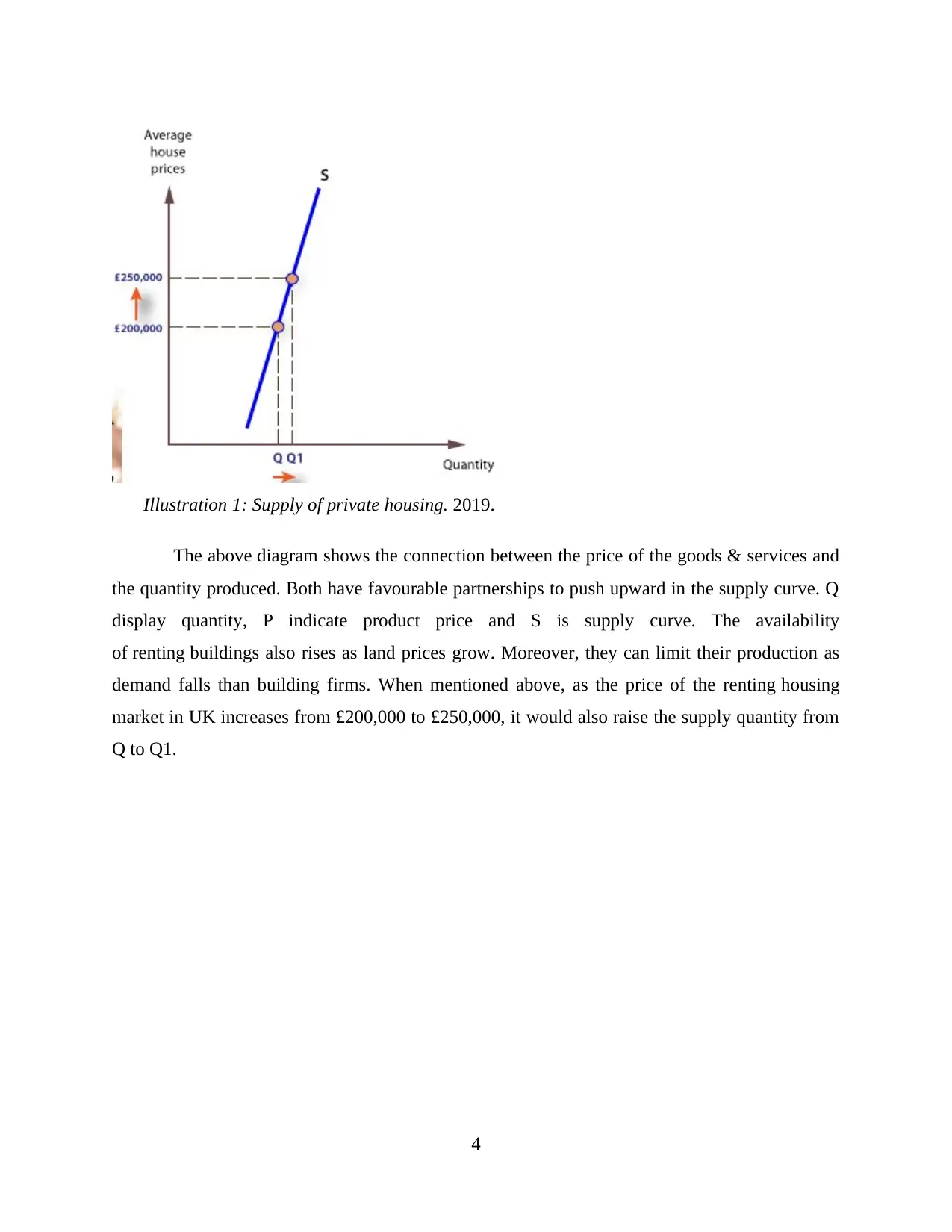
Illustration 1: Supply of private housing. 2019.
The above diagram shows the connection between the price of the goods & services and
the quantity produced. Both have favourable partnerships to push upward in the supply curve. Q
display quantity, P indicate product price and S is supply curve. The availability
of renting buildings also rises as land prices grow. Moreover, they can limit their production as
demand falls than building firms. When mentioned above, as the price of the renting housing
market in UK increases from £200,000 to £250,000, it would also raise the supply quantity from
Q to Q1.
4
The above diagram shows the connection between the price of the goods & services and
the quantity produced. Both have favourable partnerships to push upward in the supply curve. Q
display quantity, P indicate product price and S is supply curve. The availability
of renting buildings also rises as land prices grow. Moreover, they can limit their production as
demand falls than building firms. When mentioned above, as the price of the renting housing
market in UK increases from £200,000 to £250,000, it would also raise the supply quantity from
Q to Q1.
4
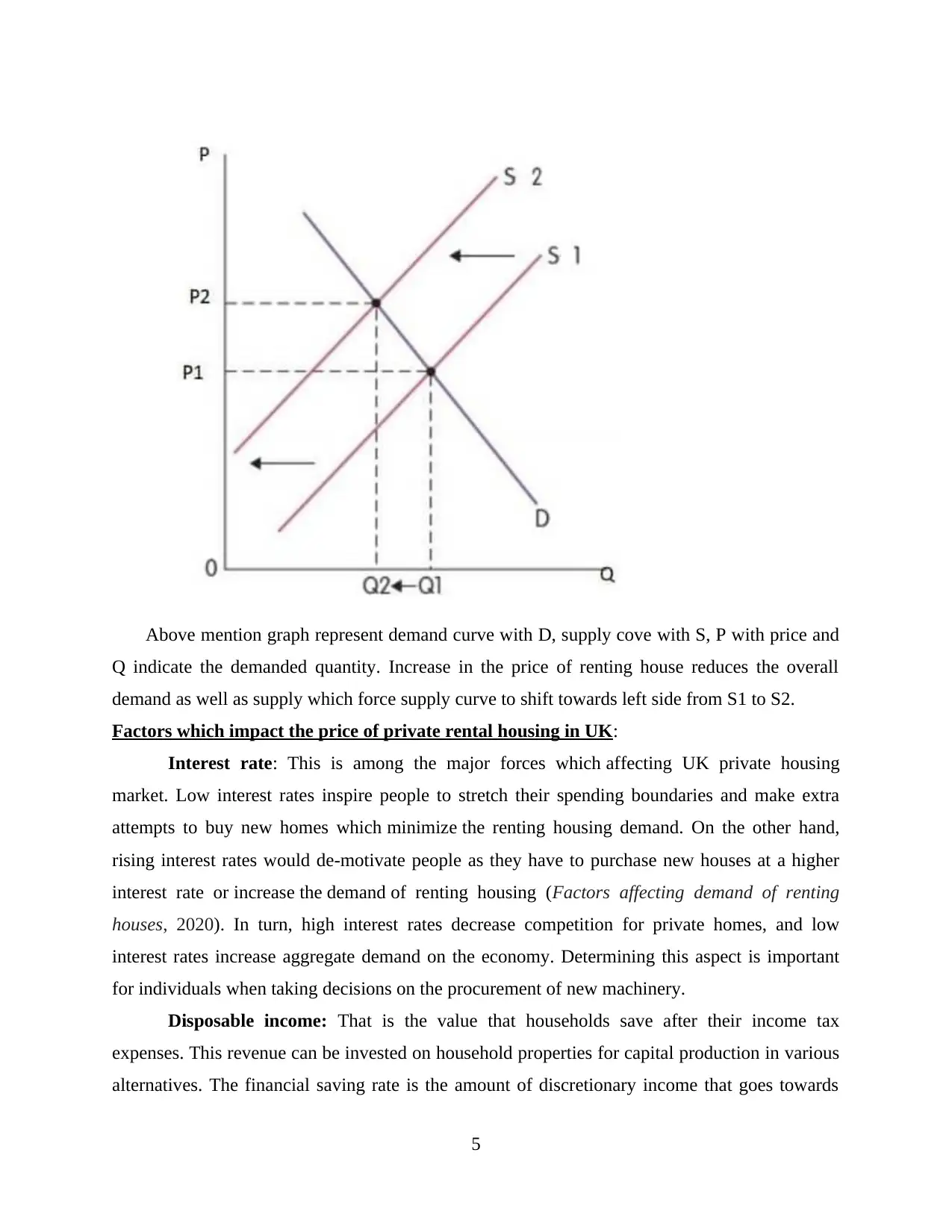
Above mention graph represent demand curve with D, supply cove with S, P with price and
Q indicate the demanded quantity. Increase in the price of renting house reduces the overall
demand as well as supply which force supply curve to shift towards left side from S1 to S2.
Factors which impact the price of private rental housing in UK:
Interest rate: This is among the major forces which affecting UK private housing
market. Low interest rates inspire people to stretch their spending boundaries and make extra
attempts to buy new homes which minimize the renting housing demand. On the other hand,
rising interest rates would de-motivate people as they have to purchase new houses at a higher
interest rate or increase the demand of renting housing (Factors affecting demand of renting
houses, 2020). In turn, high interest rates decrease competition for private homes, and low
interest rates increase aggregate demand on the economy. Determining this aspect is important
for individuals when taking decisions on the procurement of new machinery.
Disposable income: That is the value that households save after their income tax
expenses. This revenue can be invested on household properties for capital production in various
alternatives. The financial saving rate is the amount of discretionary income that goes towards
5
Q indicate the demanded quantity. Increase in the price of renting house reduces the overall
demand as well as supply which force supply curve to shift towards left side from S1 to S2.
Factors which impact the price of private rental housing in UK:
Interest rate: This is among the major forces which affecting UK private housing
market. Low interest rates inspire people to stretch their spending boundaries and make extra
attempts to buy new homes which minimize the renting housing demand. On the other hand,
rising interest rates would de-motivate people as they have to purchase new houses at a higher
interest rate or increase the demand of renting housing (Factors affecting demand of renting
houses, 2020). In turn, high interest rates decrease competition for private homes, and low
interest rates increase aggregate demand on the economy. Determining this aspect is important
for individuals when taking decisions on the procurement of new machinery.
Disposable income: That is the value that households save after their income tax
expenses. This revenue can be invested on household properties for capital production in various
alternatives. The financial saving rate is the amount of discretionary income that goes towards
5
Paraphrase This Document
Need a fresh take? Get an instant paraphrase of this document with our AI Paraphraser
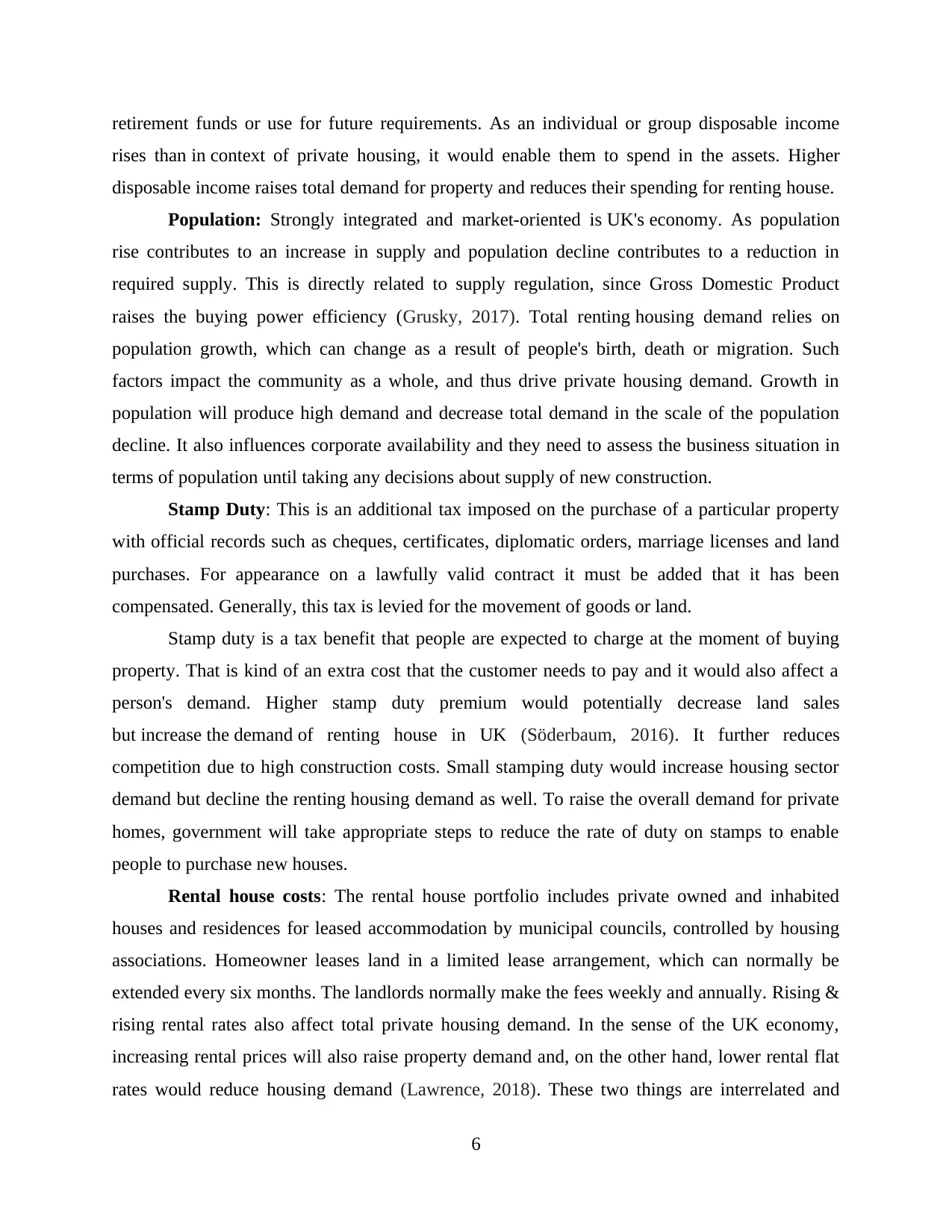
retirement funds or use for future requirements. As an individual or group disposable income
rises than in context of private housing, it would enable them to spend in the assets. Higher
disposable income raises total demand for property and reduces their spending for renting house.
Population: Strongly integrated and market-oriented is UK's economy. As population
rise contributes to an increase in supply and population decline contributes to a reduction in
required supply. This is directly related to supply regulation, since Gross Domestic Product
raises the buying power efficiency (Grusky, 2017). Total renting housing demand relies on
population growth, which can change as a result of people's birth, death or migration. Such
factors impact the community as a whole, and thus drive private housing demand. Growth in
population will produce high demand and decrease total demand in the scale of the population
decline. It also influences corporate availability and they need to assess the business situation in
terms of population until taking any decisions about supply of new construction.
Stamp Duty: This is an additional tax imposed on the purchase of a particular property
with official records such as cheques, certificates, diplomatic orders, marriage licenses and land
purchases. For appearance on a lawfully valid contract it must be added that it has been
compensated. Generally, this tax is levied for the movement of goods or land.
Stamp duty is a tax benefit that people are expected to charge at the moment of buying
property. That is kind of an extra cost that the customer needs to pay and it would also affect a
person's demand. Higher stamp duty premium would potentially decrease land sales
but increase the demand of renting house in UK (Söderbaum, 2016). It further reduces
competition due to high construction costs. Small stamping duty would increase housing sector
demand but decline the renting housing demand as well. To raise the overall demand for private
homes, government will take appropriate steps to reduce the rate of duty on stamps to enable
people to purchase new houses.
Rental house costs: The rental house portfolio includes private owned and inhabited
houses and residences for leased accommodation by municipal councils, controlled by housing
associations. Homeowner leases land in a limited lease arrangement, which can normally be
extended every six months. The landlords normally make the fees weekly and annually. Rising &
rising rental rates also affect total private housing demand. In the sense of the UK economy,
increasing rental prices will also raise property demand and, on the other hand, lower rental flat
rates would reduce housing demand (Lawrence, 2018). These two things are interrelated and
6
rises than in context of private housing, it would enable them to spend in the assets. Higher
disposable income raises total demand for property and reduces their spending for renting house.
Population: Strongly integrated and market-oriented is UK's economy. As population
rise contributes to an increase in supply and population decline contributes to a reduction in
required supply. This is directly related to supply regulation, since Gross Domestic Product
raises the buying power efficiency (Grusky, 2017). Total renting housing demand relies on
population growth, which can change as a result of people's birth, death or migration. Such
factors impact the community as a whole, and thus drive private housing demand. Growth in
population will produce high demand and decrease total demand in the scale of the population
decline. It also influences corporate availability and they need to assess the business situation in
terms of population until taking any decisions about supply of new construction.
Stamp Duty: This is an additional tax imposed on the purchase of a particular property
with official records such as cheques, certificates, diplomatic orders, marriage licenses and land
purchases. For appearance on a lawfully valid contract it must be added that it has been
compensated. Generally, this tax is levied for the movement of goods or land.
Stamp duty is a tax benefit that people are expected to charge at the moment of buying
property. That is kind of an extra cost that the customer needs to pay and it would also affect a
person's demand. Higher stamp duty premium would potentially decrease land sales
but increase the demand of renting house in UK (Söderbaum, 2016). It further reduces
competition due to high construction costs. Small stamping duty would increase housing sector
demand but decline the renting housing demand as well. To raise the overall demand for private
homes, government will take appropriate steps to reduce the rate of duty on stamps to enable
people to purchase new houses.
Rental house costs: The rental house portfolio includes private owned and inhabited
houses and residences for leased accommodation by municipal councils, controlled by housing
associations. Homeowner leases land in a limited lease arrangement, which can normally be
extended every six months. The landlords normally make the fees weekly and annually. Rising &
rising rental rates also affect total private housing demand. In the sense of the UK economy,
increasing rental prices will also raise property demand and, on the other hand, lower rental flat
rates would reduce housing demand (Lawrence, 2018). These two things are interrelated and
6
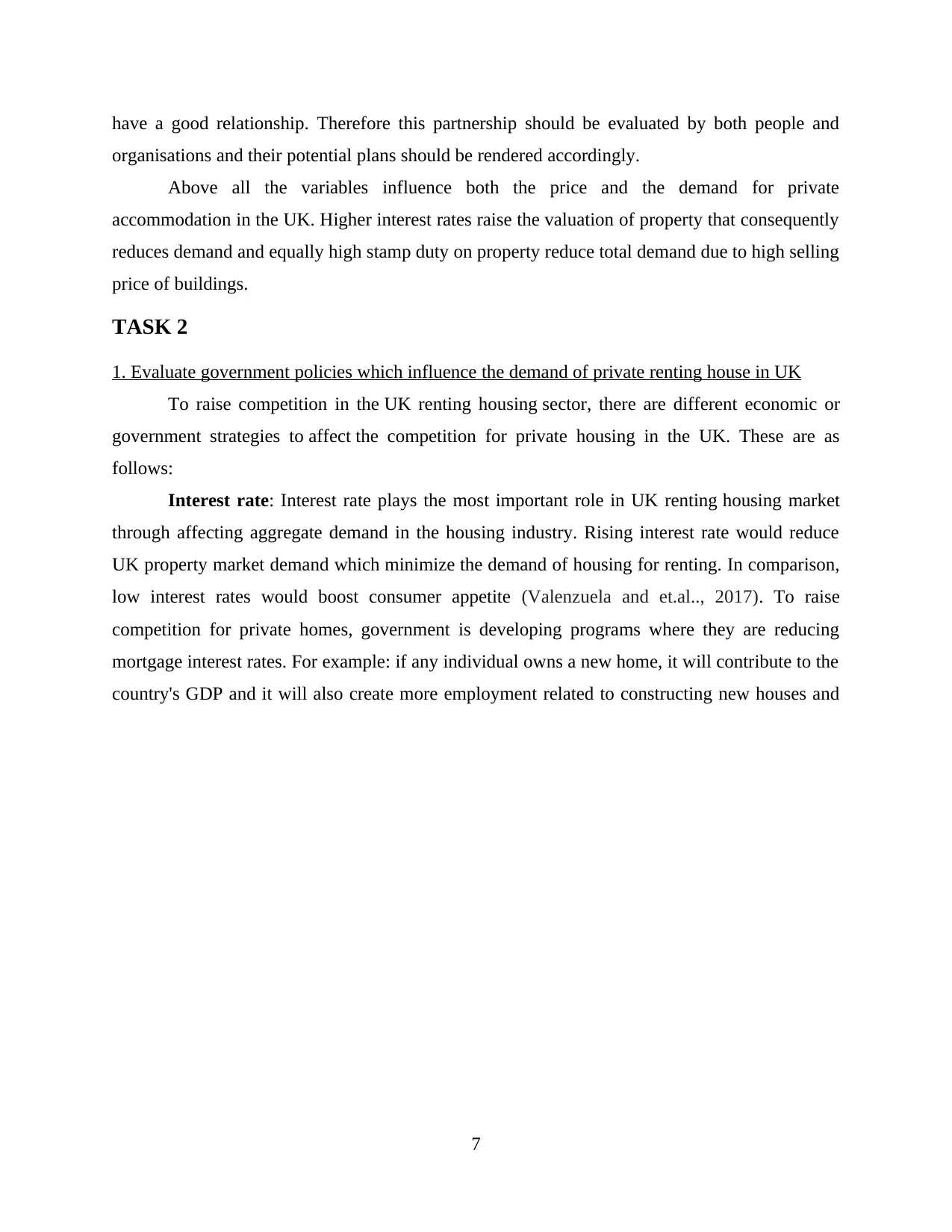
have a good relationship. Therefore this partnership should be evaluated by both people and
organisations and their potential plans should be rendered accordingly.
Above all the variables influence both the price and the demand for private
accommodation in the UK. Higher interest rates raise the valuation of property that consequently
reduces demand and equally high stamp duty on property reduce total demand due to high selling
price of buildings.
TASK 2
1. Evaluate government policies which influence the demand of private renting house in UK
To raise competition in the UK renting housing sector, there are different economic or
government strategies to affect the competition for private housing in the UK. These are as
follows:
Interest rate: Interest rate plays the most important role in UK renting housing market
through affecting aggregate demand in the housing industry. Rising interest rate would reduce
UK property market demand which minimize the demand of housing for renting. In comparison,
low interest rates would boost consumer appetite (Valenzuela and et.al.., 2017). To raise
competition for private homes, government is developing programs where they are reducing
mortgage interest rates. For example: if any individual owns a new home, it will contribute to the
country's GDP and it will also create more employment related to constructing new houses and
7
organisations and their potential plans should be rendered accordingly.
Above all the variables influence both the price and the demand for private
accommodation in the UK. Higher interest rates raise the valuation of property that consequently
reduces demand and equally high stamp duty on property reduce total demand due to high selling
price of buildings.
TASK 2
1. Evaluate government policies which influence the demand of private renting house in UK
To raise competition in the UK renting housing sector, there are different economic or
government strategies to affect the competition for private housing in the UK. These are as
follows:
Interest rate: Interest rate plays the most important role in UK renting housing market
through affecting aggregate demand in the housing industry. Rising interest rate would reduce
UK property market demand which minimize the demand of housing for renting. In comparison,
low interest rates would boost consumer appetite (Valenzuela and et.al.., 2017). To raise
competition for private homes, government is developing programs where they are reducing
mortgage interest rates. For example: if any individual owns a new home, it will contribute to the
country's GDP and it will also create more employment related to constructing new houses and
7
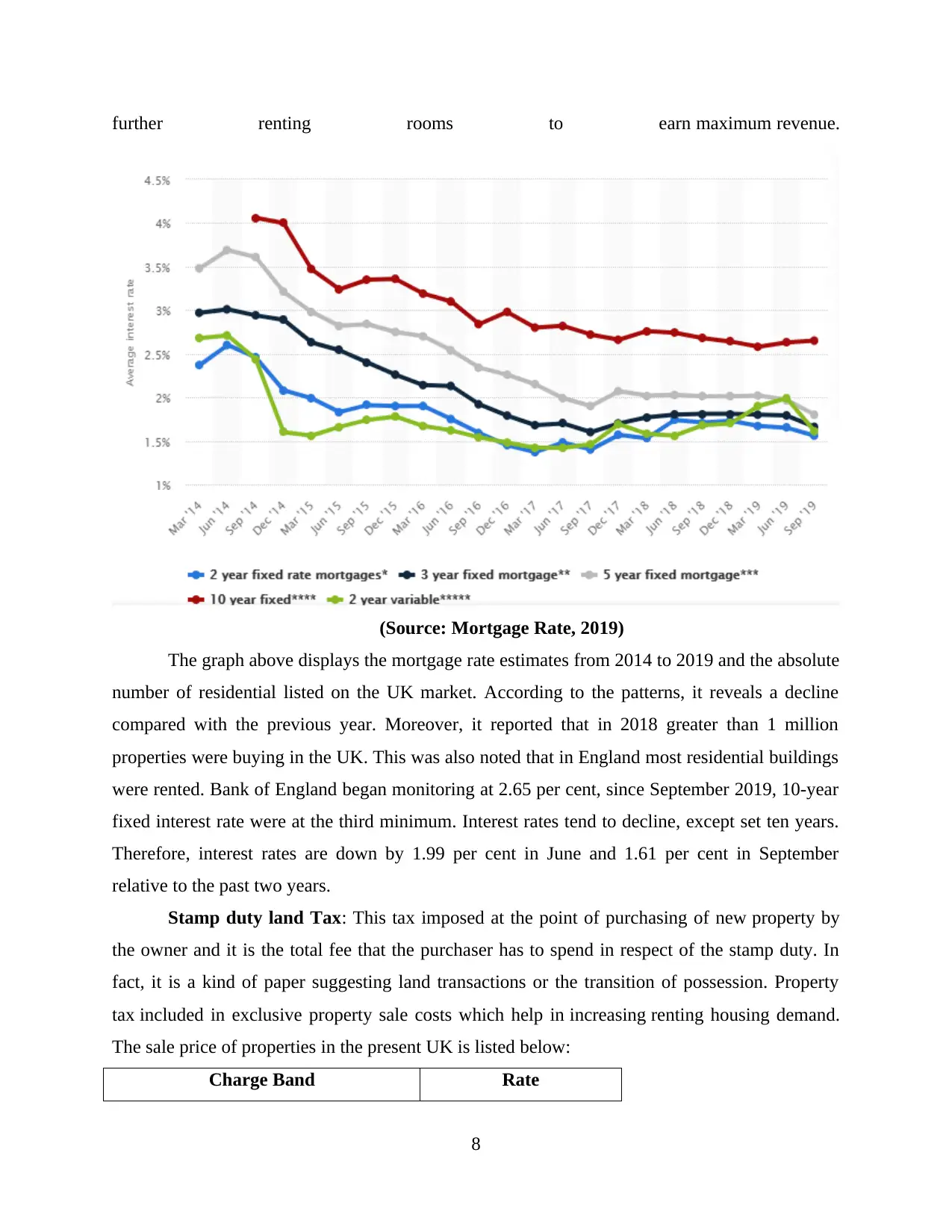
further renting rooms to earn maximum revenue.
(Source: Mortgage Rate, 2019)
The graph above displays the mortgage rate estimates from 2014 to 2019 and the absolute
number of residential listed on the UK market. According to the patterns, it reveals a decline
compared with the previous year. Moreover, it reported that in 2018 greater than 1 million
properties were buying in the UK. This was also noted that in England most residential buildings
were rented. Bank of England began monitoring at 2.65 per cent, since September 2019, 10-year
fixed interest rate were at the third minimum. Interest rates tend to decline, except set ten years.
Therefore, interest rates are down by 1.99 per cent in June and 1.61 per cent in September
relative to the past two years.
Stamp duty land Tax: This tax imposed at the point of purchasing of new property by
the owner and it is the total fee that the purchaser has to spend in respect of the stamp duty. In
fact, it is a kind of paper suggesting land transactions or the transition of possession. Property
tax included in exclusive property sale costs which help in increasing renting housing demand.
The sale price of properties in the present UK is listed below:
Charge Band Rate
8
(Source: Mortgage Rate, 2019)
The graph above displays the mortgage rate estimates from 2014 to 2019 and the absolute
number of residential listed on the UK market. According to the patterns, it reveals a decline
compared with the previous year. Moreover, it reported that in 2018 greater than 1 million
properties were buying in the UK. This was also noted that in England most residential buildings
were rented. Bank of England began monitoring at 2.65 per cent, since September 2019, 10-year
fixed interest rate were at the third minimum. Interest rates tend to decline, except set ten years.
Therefore, interest rates are down by 1.99 per cent in June and 1.61 per cent in September
relative to the past two years.
Stamp duty land Tax: This tax imposed at the point of purchasing of new property by
the owner and it is the total fee that the purchaser has to spend in respect of the stamp duty. In
fact, it is a kind of paper suggesting land transactions or the transition of possession. Property
tax included in exclusive property sale costs which help in increasing renting housing demand.
The sale price of properties in the present UK is listed below:
Charge Band Rate
8
Secure Best Marks with AI Grader
Need help grading? Try our AI Grader for instant feedback on your assignments.
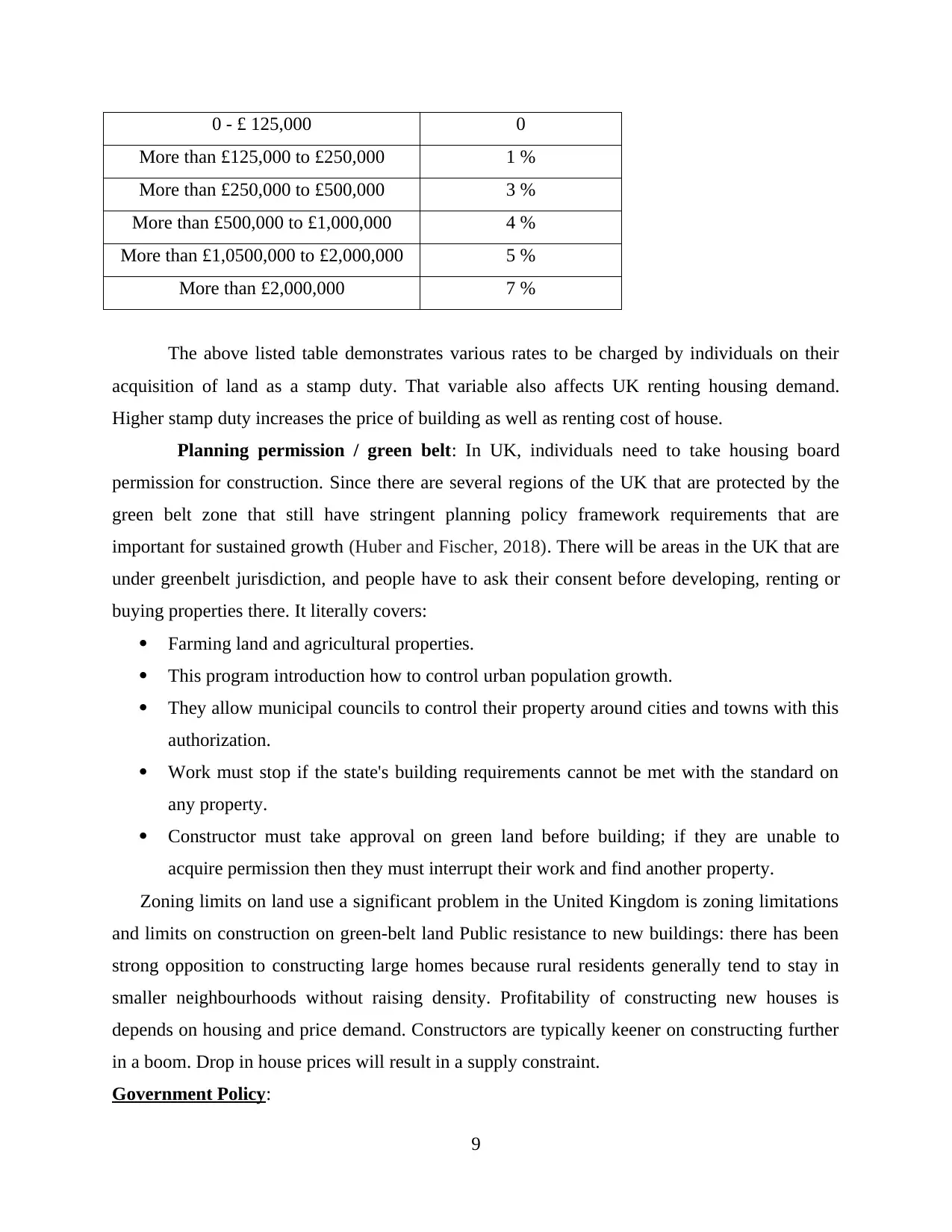
0 - £ 125,000 0
More than £125,000 to £250,000 1 %
More than £250,000 to £500,000 3 %
More than £500,000 to £1,000,000 4 %
More than £1,0500,000 to £2,000,000 5 %
More than £2,000,000 7 %
The above listed table demonstrates various rates to be charged by individuals on their
acquisition of land as a stamp duty. That variable also affects UK renting housing demand.
Higher stamp duty increases the price of building as well as renting cost of house.
Planning permission / green belt: In UK, individuals need to take housing board
permission for construction. Since there are several regions of the UK that are protected by the
green belt zone that still have stringent planning policy framework requirements that are
important for sustained growth (Huber and Fischer, 2018). There will be areas in the UK that are
under greenbelt jurisdiction, and people have to ask their consent before developing, renting or
buying properties there. It literally covers:
Farming land and agricultural properties.
This program introduction how to control urban population growth.
They allow municipal councils to control their property around cities and towns with this
authorization.
Work must stop if the state's building requirements cannot be met with the standard on
any property.
Constructor must take approval on green land before building; if they are unable to
acquire permission then they must interrupt their work and find another property.
Zoning limits on land use a significant problem in the United Kingdom is zoning limitations
and limits on construction on green-belt land Public resistance to new buildings: there has been
strong opposition to constructing large homes because rural residents generally tend to stay in
smaller neighbourhoods without raising density. Profitability of constructing new houses is
depends on housing and price demand. Constructors are typically keener on constructing further
in a boom. Drop in house prices will result in a supply constraint.
Government Policy:
9
More than £125,000 to £250,000 1 %
More than £250,000 to £500,000 3 %
More than £500,000 to £1,000,000 4 %
More than £1,0500,000 to £2,000,000 5 %
More than £2,000,000 7 %
The above listed table demonstrates various rates to be charged by individuals on their
acquisition of land as a stamp duty. That variable also affects UK renting housing demand.
Higher stamp duty increases the price of building as well as renting cost of house.
Planning permission / green belt: In UK, individuals need to take housing board
permission for construction. Since there are several regions of the UK that are protected by the
green belt zone that still have stringent planning policy framework requirements that are
important for sustained growth (Huber and Fischer, 2018). There will be areas in the UK that are
under greenbelt jurisdiction, and people have to ask their consent before developing, renting or
buying properties there. It literally covers:
Farming land and agricultural properties.
This program introduction how to control urban population growth.
They allow municipal councils to control their property around cities and towns with this
authorization.
Work must stop if the state's building requirements cannot be met with the standard on
any property.
Constructor must take approval on green land before building; if they are unable to
acquire permission then they must interrupt their work and find another property.
Zoning limits on land use a significant problem in the United Kingdom is zoning limitations
and limits on construction on green-belt land Public resistance to new buildings: there has been
strong opposition to constructing large homes because rural residents generally tend to stay in
smaller neighbourhoods without raising density. Profitability of constructing new houses is
depends on housing and price demand. Constructors are typically keener on constructing further
in a boom. Drop in house prices will result in a supply constraint.
Government Policy:
9
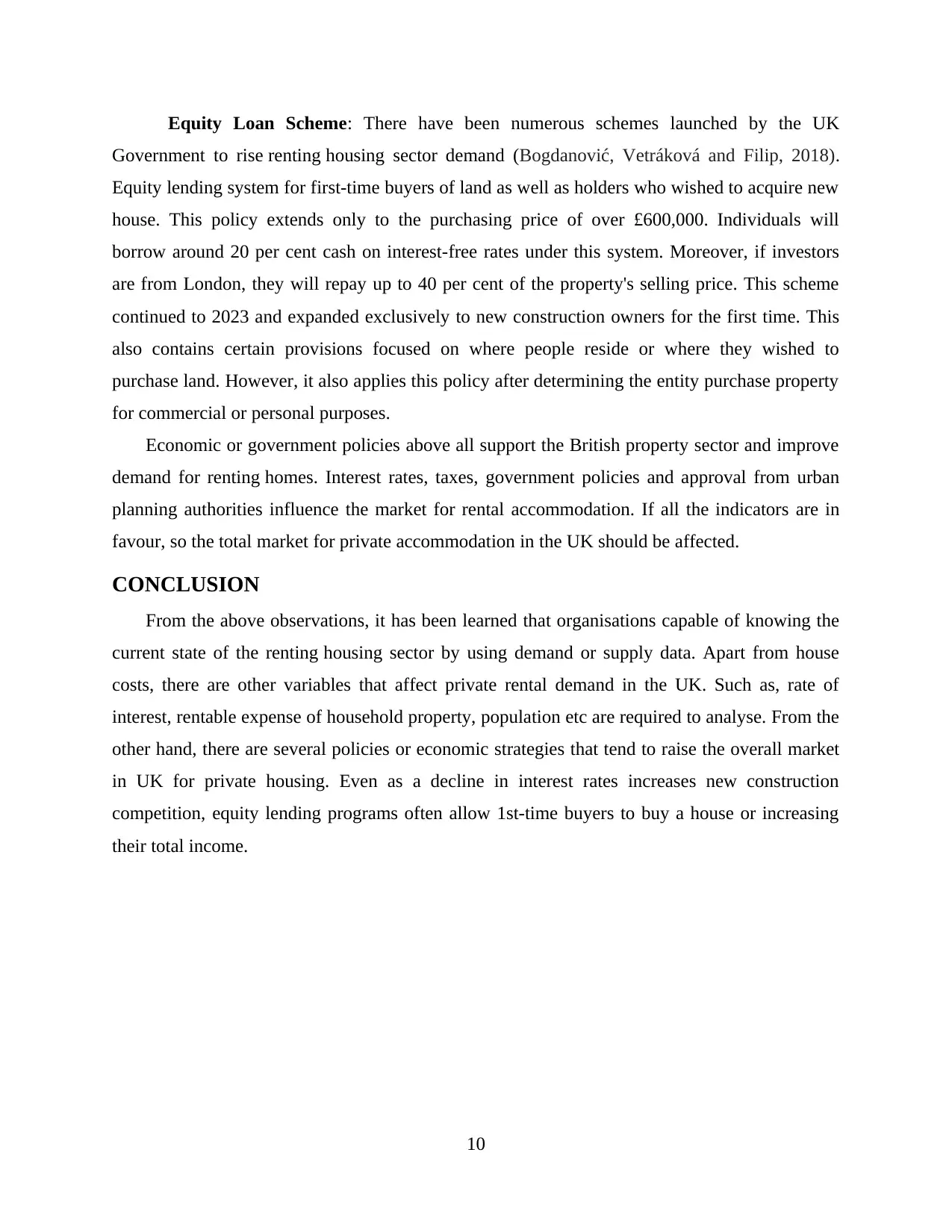
Equity Loan Scheme: There have been numerous schemes launched by the UK
Government to rise renting housing sector demand (Bogdanović, Vetráková and Filip, 2018).
Equity lending system for first-time buyers of land as well as holders who wished to acquire new
house. This policy extends only to the purchasing price of over £600,000. Individuals will
borrow around 20 per cent cash on interest-free rates under this system. Moreover, if investors
are from London, they will repay up to 40 per cent of the property's selling price. This scheme
continued to 2023 and expanded exclusively to new construction owners for the first time. This
also contains certain provisions focused on where people reside or where they wished to
purchase land. However, it also applies this policy after determining the entity purchase property
for commercial or personal purposes.
Economic or government policies above all support the British property sector and improve
demand for renting homes. Interest rates, taxes, government policies and approval from urban
planning authorities influence the market for rental accommodation. If all the indicators are in
favour, so the total market for private accommodation in the UK should be affected.
CONCLUSION
From the above observations, it has been learned that organisations capable of knowing the
current state of the renting housing sector by using demand or supply data. Apart from house
costs, there are other variables that affect private rental demand in the UK. Such as, rate of
interest, rentable expense of household property, population etc are required to analyse. From the
other hand, there are several policies or economic strategies that tend to raise the overall market
in UK for private housing. Even as a decline in interest rates increases new construction
competition, equity lending programs often allow 1st-time buyers to buy a house or increasing
their total income.
10
Government to rise renting housing sector demand (Bogdanović, Vetráková and Filip, 2018).
Equity lending system for first-time buyers of land as well as holders who wished to acquire new
house. This policy extends only to the purchasing price of over £600,000. Individuals will
borrow around 20 per cent cash on interest-free rates under this system. Moreover, if investors
are from London, they will repay up to 40 per cent of the property's selling price. This scheme
continued to 2023 and expanded exclusively to new construction owners for the first time. This
also contains certain provisions focused on where people reside or where they wished to
purchase land. However, it also applies this policy after determining the entity purchase property
for commercial or personal purposes.
Economic or government policies above all support the British property sector and improve
demand for renting homes. Interest rates, taxes, government policies and approval from urban
planning authorities influence the market for rental accommodation. If all the indicators are in
favour, so the total market for private accommodation in the UK should be affected.
CONCLUSION
From the above observations, it has been learned that organisations capable of knowing the
current state of the renting housing sector by using demand or supply data. Apart from house
costs, there are other variables that affect private rental demand in the UK. Such as, rate of
interest, rentable expense of household property, population etc are required to analyse. From the
other hand, there are several policies or economic strategies that tend to raise the overall market
in UK for private housing. Even as a decline in interest rates increases new construction
competition, equity lending programs often allow 1st-time buyers to buy a house or increasing
their total income.
10
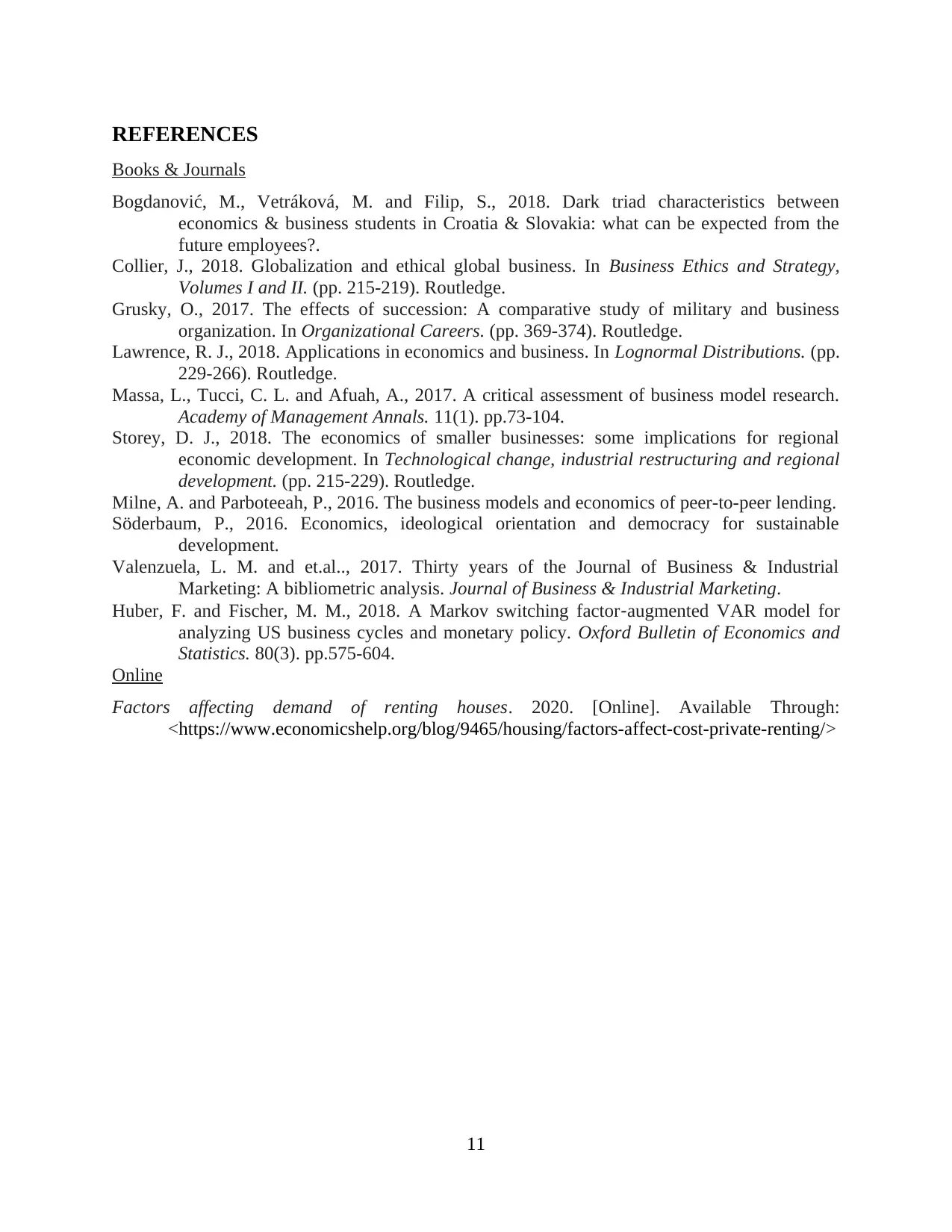
REFERENCES
Books & Journals
Bogdanović, M., Vetráková, M. and Filip, S., 2018. Dark triad characteristics between
economics & business students in Croatia & Slovakia: what can be expected from the
future employees?.
Collier, J., 2018. Globalization and ethical global business. In Business Ethics and Strategy,
Volumes I and II. (pp. 215-219). Routledge.
Grusky, O., 2017. The effects of succession: A comparative study of military and business
organization. In Organizational Careers. (pp. 369-374). Routledge.
Lawrence, R. J., 2018. Applications in economics and business. In Lognormal Distributions. (pp.
229-266). Routledge.
Massa, L., Tucci, C. L. and Afuah, A., 2017. A critical assessment of business model research.
Academy of Management Annals. 11(1). pp.73-104.
Storey, D. J., 2018. The economics of smaller businesses: some implications for regional
economic development. In Technological change, industrial restructuring and regional
development. (pp. 215-229). Routledge.
Milne, A. and Parboteeah, P., 2016. The business models and economics of peer-to-peer lending.
Söderbaum, P., 2016. Economics, ideological orientation and democracy for sustainable
development.
Valenzuela, L. M. and et.al.., 2017. Thirty years of the Journal of Business & Industrial
Marketing: A bibliometric analysis. Journal of Business & Industrial Marketing.
Huber, F. and Fischer, M. M., 2018. A Markov switching factor‐augmented VAR model for
analyzing US business cycles and monetary policy. Oxford Bulletin of Economics and
Statistics. 80(3). pp.575-604.
Online
Factors affecting demand of renting houses. 2020. [Online]. Available Through:
<https://www.economicshelp.org/blog/9465/housing/factors-affect-cost-private-renting/>
11
Books & Journals
Bogdanović, M., Vetráková, M. and Filip, S., 2018. Dark triad characteristics between
economics & business students in Croatia & Slovakia: what can be expected from the
future employees?.
Collier, J., 2018. Globalization and ethical global business. In Business Ethics and Strategy,
Volumes I and II. (pp. 215-219). Routledge.
Grusky, O., 2017. The effects of succession: A comparative study of military and business
organization. In Organizational Careers. (pp. 369-374). Routledge.
Lawrence, R. J., 2018. Applications in economics and business. In Lognormal Distributions. (pp.
229-266). Routledge.
Massa, L., Tucci, C. L. and Afuah, A., 2017. A critical assessment of business model research.
Academy of Management Annals. 11(1). pp.73-104.
Storey, D. J., 2018. The economics of smaller businesses: some implications for regional
economic development. In Technological change, industrial restructuring and regional
development. (pp. 215-229). Routledge.
Milne, A. and Parboteeah, P., 2016. The business models and economics of peer-to-peer lending.
Söderbaum, P., 2016. Economics, ideological orientation and democracy for sustainable
development.
Valenzuela, L. M. and et.al.., 2017. Thirty years of the Journal of Business & Industrial
Marketing: A bibliometric analysis. Journal of Business & Industrial Marketing.
Huber, F. and Fischer, M. M., 2018. A Markov switching factor‐augmented VAR model for
analyzing US business cycles and monetary policy. Oxford Bulletin of Economics and
Statistics. 80(3). pp.575-604.
Online
Factors affecting demand of renting houses. 2020. [Online]. Available Through:
<https://www.economicshelp.org/blog/9465/housing/factors-affect-cost-private-renting/>
11
1 out of 13
Related Documents
Your All-in-One AI-Powered Toolkit for Academic Success.
+13062052269
info@desklib.com
Available 24*7 on WhatsApp / Email
![[object Object]](/_next/static/media/star-bottom.7253800d.svg)
Unlock your academic potential
© 2024 | Zucol Services PVT LTD | All rights reserved.





